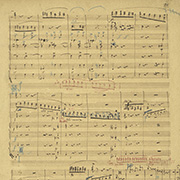The new editions of Dvořák’s celebrated Serenades, op. 22 for strings and op. 44 for wind instruments, cello and double bass, are only the second critical editions since first publications in 1879, although Otakar Šourek’s 1955 edition of op. 22 and František Bartoš’ 1956 edition of op. 44 delivered authoritative and scholarly scores. Nonetheless, scrutiny of each autograph reveals fascinating details, perhaps missed in initial editing in op. 22 especially and which found their way into print, to be reproduced in later editions. A fresh look at these two masterpieces of their genre seemed timely.
Both works were composed rapidly and with seeming ease, op. 22 in May 1875 and op. 44 in January 1878. Despite having the same year of publication, they took very different journeys from autograph to first edition, and it is fascinating to witness Dvořák’s growing status as a composer through the different ways in which publishers treated them. Op. 22 was an immediate success when first performed in December 1876, but publishers in Prague were wary of committing expensive costs to the work: it was only thanks to the intervention of the music critic V. V. Zelený, and to a group of Dvořák’s friends, that money was raised for publication of the composer’s piano duet arrangement, printed by Starý in 1877.
The case of op. 44 is completely different, demonstrating the significant increase in popularity and in reputation which Dvořák had achieved by 1879. It is well known that this improvement in his fortunes was due substantially to the influence of Johannes Brahms. Brahms introduced Dvořák to his Berlin publisher, Fritz Simrock, in 1877, impressed by many of Dvořák’s early works. Due to Simrock’s hugely successful editions of the Moravian Duets, and especially of the first set of Slavonic Dances, Dvořák’s reputation began to spread far beyond his own country. The op. 44 Serenade was snapped up by Simrock, along with many other compositions: Dvořák had become eminently marketable. Other publishers then began to take a serious interest in his music, and it was now that Bote & Bock acquired the Serenade op. 22, publishing it in 1879. Thus both Serenades, composed nearly three years apart, were released to the public almost simultaneously.
Given that both autographs were edited at the same time, one might expect broadly similar approaches from each publishing house. This is very far from the case. Bote & Bock’s editing left in place many inconsistencies, in articulation and dynamics especially; moreover, occasional wrong notes were introduced or left uncorrected; the approach might even be described as cursory. On the other hand, the score of op. 44 is thick with blue pencil, with a supplementary layer of editing in red ink. In each case, although Dvořák would undoubtedly have corrected the proofs, he was also busy with other composition projects in 1879, and this task may have been approached with less than total concentration.
The new editions re-examine in detail both autographs, aiming to produce scores which are true to their original conception. In op. 22, for example, cuts made in movements III and V are restored, marked as Vide sections. As regards op. 44, it has been rewarding to examine again some of the editing decisions made by Simrock, and in some cases to return to Dvořák’s original ideas, clarifying occasional textures, for example in some horn parts, where Simrock’s edition delivers some rather overdone accentuation.
These wonderful Serenades are among the most memorable of Dvořák’s works, and it is hoped that our editions will kindle fresh interest in them, encouraging performances at a time when scholarly interest in Dvořák is at its most intense.
Robin Tait
(from [t]akte 1/2016)



